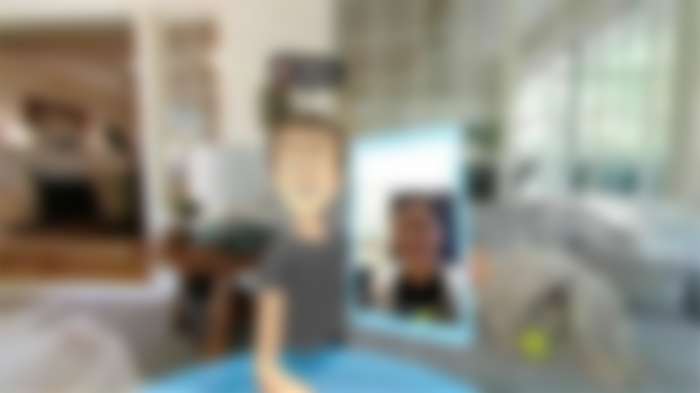With the programmed democratization of virtual reality, the number one in social networks could well follow in the footsteps of the famous 3D universe.

With the programmed democratization of virtual reality tools, the number one social network could end up walking in the footsteps of the 3D universe that appeared thirteen years ago. In less cheap and much more profitable.
On October 6, 2016, in San José (California), Marc Zuckerberg gave a small demo of future Facebook developments in the field of virtual reality. On stage, the normcore CEO , eternal jeans and a plain plain t-shirt, equipped with his Oculus Rift headset (company bought at a gold price in 2014), “teleported” his avatar - sketchy and cartoony model of said Zuck '- from the conference room to the Facebook premises to his apartment, and interact with the avatars of several people located miles away.

With the programmed democratization of virtual reality tools, the number one social network could end up walking in the footsteps of the 3D universe that appeared thirteen years ago. In less cheap and much more profitable.
On October 6, 2016, in San José (California), Marc Zuckerberg gave a small demo of future Facebook developments in the field of virtual reality. On stage, the normcore CEO , eternal jeans and a plain plain t-shirt, equipped with his Oculus Rift headset (company bought at a gold price in 2014), “teleported” his avatar - sketchy and cartoony model of said Zuck '- from the conference room to the Facebook premises to his apartment, and interact with the avatars of several people located miles away.
Holographic teleportation
Facebook's embrace of virtual reality is hardly surprising. Marc Zuckerberg has been talking about the idea of “holographic teleportation” for several years . His definitive conversion to virtual reality (VR) dates back to his time at the Virtual human interaction lab at the prestigious and pioneering Stanford University, led by the specialist in virtual worlds Jeremy Bailenson , where some of the most advanced experiments are conducted. in the matter. If helmets and other VR equipment become more democratic in the years to come, we could therefore enter a new age, that of “social virtual reality” - literally “social virtual reality”.
"We will see technologies related to avatars and virtual worlds migrate from video games to social networks"
It will no longer be a question of going “on” Facebook but “in” Facebook . “Imagine your best friend seeing you in 3D, projected in his living room, your avatar faithful to the detail to your physical appearance, meticulously reproducing all your expressions ... In the next three years, we will see the technologies related to avatars and virtual worlds migrate from video games, where they are already very present, to social networks ” predicts Matthias McCoy-Thompson, founder of AgoraVR, an American platform dedicated to virtual reality. By taking this path, Facebook would therefore become a virtual world in its own right, nothing less. Or, more exactly, Facebook would help to permanently merge reality into virtuality.

Second Life, the ancestor of the metaverse
The utopia of virtual worlds is not new. Truth be told, it even embraces the history of computing. It also draws heavily on literature, especially science fiction novels. To understand the evolutions underway, many cite as a marker the notion of “metaverse” (“metaverse” in English, fusion of the terms “meta” and “universe”), originally developed by Neal Stephenson in his prophetic novel Snow Crash , published in 1992. The “metaverse” is a virtual world, created by a computer program, in which users, via avatars in their image, meet to work, socialize and play.
Since this founding act, we no longer count the very real attempts to give shape to functional virtual worlds - and no longer just fictional ones. The most emblematic is undoubtedly Second Life , which appeared in 2003 and is still active, even if the universe has been deserted, the fault of technical weaknesses and a rudimentary aesthetic to say the least. Philip Rosendale, its founder, also claims the term “metaverse” to qualify his virtual baby. “Second Life was a metaverse without an Oculus Rift headset,” points out Aurélien Fache, digital entrepreneur.
With the new possibilities offered by new virtual reality equipment, many companies are now investing in the field of “social VR”. Applications such as AltspaceVR , JanusVR , VRChat or even vTime, already allow a few thousand early adopters to chat, meet, play or watch movies together through their headsets.
Other players are trying to take over from Second Life and build universes ready to be invested by thousands, even millions, of users. Starting with the creator of Second Life himself, Philip Rosendale, with his new High Fidelity project . “ Marc Zuckerberg's demo, with his Oculus, is pure provocation ,” says Aurélien Fache. There is nothing new here. On the other hand, what is interesting is the strike force of Facebook, its ability to reach and convert millions, if not billions, of people to virtual reality. And when you see his teams, who come from Second Life and the best VR labs, you can take it seriously ” .
Walk in the Tangier of the 1950s
But what will a virtual world made in Facebook look like? Perhaps in "Doppel" , the universe imagined by American novelist Richard MacManus in his latest book Presence (CreateSpace Independent Publishing Platform, 2016). “Doppel is the Facebook of the 2050s, ” explains the author, “ used by billions of people every day to go to work and play”.In this universe, avatars are a faithful reproduction of ourselves and anonymity does not exist. Life unfolds above all in networks. Large companies share its territories and create "theme parks". It is a largely privatized virtual world. In a scene from the novel, Gats, the main character, goes to one of these parks, a faithful reproduction of the Tanger beat of the 1950s. Drugs, sex, prostitution, old buildings… Everything is there, perfectly reconstructed. “There is a 'warning' dimension in my book. What will happen to our identity when we keep moving from the physical to the virtual world, and when the boundaries of time and space are abolished? asks Richard MacManus. In Presence, some characters lose empathy, become violent. Others simply enjoy new pleasures, such as traveling without limits ” .

Follow the example of the iPhone
A condition in the advent of such virtual universes will undoubtedly be their open or closed character. “Users and creators must be able to take hold of virtual reality,” emphasizes Aurélien Fache. In a sense, you have to follow the development model of smartphones, and in particular the iPhone. Its success lies in the fact that everyone has been able to create applications, content and thus contribute to its ecosystem. This is what Oculus is doing today, trying to open up as much as possible ”. The opening therefore, even if it should be noted that all the applications available on the AppStore today pass under the caudine forks of Apple ...
“In seven years, the mobile telephony market has grown from 0 to 2.5 billion users. It will be the same with virtual reality ”
Philipe Rosedale, in a recent Ted conference, also adds to the telephone analogy: “In seven years, the mobile telephony market has grown from 0 to 2.5 billion users. It will be the same with virtual reality, ”he announces. But what will be the social and economic relations induced by the opening of these new worlds, governed by the computer code and the conditions of use of private companies? What about technical questions, interoperability for example, that is to say the possibility of freely walking your avatar from one virtual world to another?
Many questions remain unanswered today. The only certainty: if the utopia of virtual worlds has often flirted with the egalitarian dream, it risks being overtaken - or more simply carried - by old economic reflexes and the quest for profit, particularly in the case of Facebook. Barely born, Second Life was already trusted in its time by brands. It is also this scenario that Richard MacManus develops in his novel Presence . In a few years, therefore, we will perhaps be forced to agree with William Gibson, the author of the great classic of the SF Neuromancer , who, after discovering the existence of Second Life , had reacted in these terms:"It's a bad mix between the Edmonton mall and my worst day in high school."



